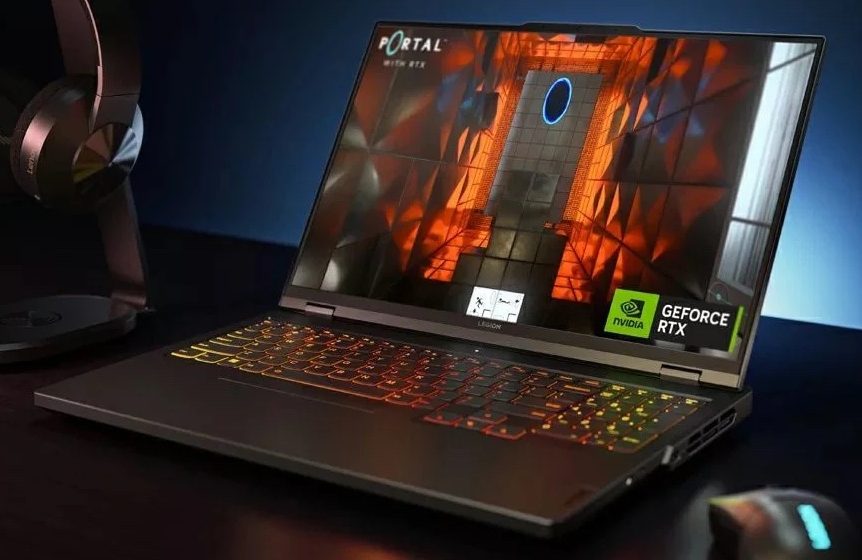Some of the best gaming laptops available today are coming out of Lenovo’s Legion stable, offering access to a wide range of performance hardware, displays, and—perhaps most importantly—price points. While the Legion Pro 7i (Gen 8) might be our current favorite, its high-end design, features, and performance put it in a price range that’s beyond reasonable for a lot of people.
That’s where the AMD-powered Legion Pro 5 and the Pro 5i Intel equivalent come in. They come with a lot of the same performance hardware and display options as the Pro 7i line, but they lack a few premium features that help keep the price down. Not everyone wants extra RGB on the chassis, discrete amps for the speakers, or a full aluminum chassis, and those people can save big bucks.
The AMD-based Legion Pro 5 refreshed for 2023 comes prepacked with AMD’s Ryzen 7000 mobile chips and Nvidia RTX 40-series graphics in a chassis that’s identical to the Intel version. This review will mostly focus on how the AMD CPU compares to Intel’s abilities, as well as focus on how AMD has improved its performance on battery power with these new processors. Is this version a better choice, especially when it starts at a lower price? Let’s find out.
Lenovo Legion Pro 5 (2023)
Super AMD performance
A more affordable alternative to the Intel-based model
8.5 / 10
The AMD-based Legion Pro 5 (Gen 8) matches Intel’s performance across the board and even costs a bit less money. As long as you don’t want to step up to the flagship Pro 7i, this should be a great choice for AMD fans.
Storage 1TB M.2 PCIe 4.0 NVMe SSD, two M.2 slots, upgradeable
CPU AMD Ryzen 7 7745HX (8 cores, 16 threads
)Memory 16GB DDR5-5200MHz, dual SODIMM slots, upgradeable
Operating System: Windows 11 Home
Battery 80Wh
Ports Four USB-A 3.2 (Gen 1), two USB-C 3.2 (Gen 2), HDMI, Ethernet, 3.5mm audio
Camera1080p, eShutter
Display (Size, Resolution)16 inches, 2560×1600 (QHD+), 16:10 aspect ratio, IPS, 300 nits, AG, 100% sRGB, 165Hz refresh rate, Dolby Vision, AMD FreeSync, NVIDIA G-SYNC
Weight less than 5.5 pounds (2.5kg)
GPU NVIDIA RTX 4070 Laptop GPU
NetworkWi-Fi 6E, Bluetooth 5.1
Speakers: Dual 2W stereo, Nahimic Audio
Model 16ARX8
Pros
- No more drastic Ryzen slowdown on DC power
- Minor redesign with rounded edges looks great
- Cheaper pricing compared to the Intel model
- No throttling or overheating issues
Cons
- Slightly less battery life than Intel when directly compared
- Some coil whine under load
- No Thunderbolt 4
- Screen can suffer in bright environments
Design, ports, and keyboard: Identical to the Intel-based Pro 5i
Lenovo pulled off a minor redesign for its eighth-generation Legion gaming laptops, rounding the back edges and combining some of the plastic exhaust covers for a more seamless appearance. I love the new look, and it will likely be around for a few generations as Lenovo refines its gaming lineup.
I won’t go into too much detail concerning design, display, keyboard, and touchpad, as I already did a deep dive into these areas in my Legion Pro 5i review. The AMD and Intel laptops are physically identical with an aluminum lid and plastic base, an Onyx Grey finish, and a starting weight of about 5.5 pounds.
Ports on the AMD model include four USB-A 3.2 (Gen 1), two USB-C 3.2 (Gen 2), HDMI, RJ45 Ethernet, and a 3.5mm audio jack. This is the same port selection as in the Pro 5i, and you don’t even have to sacrifice Thunderbolt by choosing AMD. The Intel model also sticks with standard USB-C 3.2. If you do want Thunderbolt 4, you’ll have to check out the Legion Pro 7i.
Lenovo’s TrueStrike keyboard is included here, with your choice of four-zone customizable RGB, static white, or static blue lighting. The 1.5mm key travel remains comfortable even during long gaming (or typing) sessions, and the only real downside is the touchpad’s placement. It’s off-center and takes up more space than necessary beneath the WASD keys. You can disable the touchpad while gaming, but you’ll still feel the edges rub against your palm.
The front-facing camera has been upgraded to 1080p for this generation, giving would-be streamers a better option before they invest in a high-end webcam. The display’s thin bezel gives way at the top to a reverse notch that houses the camera, and it gives your fingers a bit of an extra hold when you open the laptop’s lid.
Display: Your choice of a 165Hz or 240Hz refresh rate
In my Lenovo Legion Pro 5i (Gen 8) review, I noted that the 165Hz QHD+ display had some issues dealing with glare despite the anti-glare finish. The screen in the AMD-based Legion Pro 5 is by all appearances the same hardware, with similar color reproduction and maximum brightness. I tested using a SpyderX Pro colorimeter, measuring 100% sRGB, 78% AdobeRGB, and 81% DCI-P3, with about 390 nits brightness.
Gaming in a room full of sunlight will still cause some issues, but you’ll be treated to deep contrast and color everywhere else. Games look, at best, full and rich on this screen. The X-Rite Pantone color calibration app that comes installed lets you switch between sRGB and Rec. 709 color profiles if you’re looking at getting into some professional work, and there’s Dolby Vision, NVIDIA G-Sync, AMD FreeSync, and TÜV Rheinland low blue light certification to help protect your eyes.
The 240Hz QHD+ option costs about $30 more than the 165Hz screen, and it also comes with DisplayHDR 400 and about 100 nits of extra brightness. This alone might be worth it if you often game in well-lit spaces, but I wouldn’t spend the extra money on the refresh rate alone. Competitive gamers are likely going to pick up a high-end external gaming monitor anyway, and casual players looking to enjoy modern titles should find that 165Hz is plenty smooth. There’s also the performance hardware equation in effect. As we’ll see in the next section, only Shadow of the Tomb Raider got close to 165Hz with DLSS enabled. It looks buttery smooth, and most people won’t care about an extra 80 or so ticks.
Performance: AMD is no longer wimpy when running on battery power
This was the first time getting my hands on the new AMD Ryzen 7000 HX-series chips, and I was very curious to see how they’d compare to the killer 13th-generation Intel hardware. My review unit’s AMD Ryzen 7 7745HX boasts 8 cores and 16 threads with a maximum clock of 5.1GHz, running at 55W by default; the Intel Core i7-13700HX has 16 cores, 24 threads, and a Turbo clock up to 5GHz (also running at 55W by default).
This translates into the opposite of what I’m used to seeing, with AMD ahead in multi-core performance and Intel ahead in single-core. As you can see from the synthetic benchmark results below, AMD now pulls ahead in most tests when just one core is utilized. The Core i7’s sheer number of cores helps it pull ahead at the other end, but not by as much as you might expect. Bottom line? It’s a great time to be a gamer regardless of if you align with Intel or AMD.
| Benchmark | Lenovo Legion 5 Pro (Gen 8) AMD Ryzen 7 7745HX, RTX 4070 | Lenovo Legion 5i Pro (Gen 8) Core i7-13700HX, RTX 4060 | Lenovo Legion 7i Pro (Gen 8) Core i9-13900HX, RTX 4080 | MSI Titan GT77 HX (2022) Core i9-12900HX, RTX 3080 Ti |
|---|---|---|---|---|
| PCMark 10 | 8,531 | 7,370 | 7,570 | 6,929 |
| Cinebench R23 (single / multi) | 1,843 / 17,514 | 1,888 / 19,468 | 2,069 / 27,727 | 1,928 / 21,669 |
| Geekbench 5 (single / multi) | 2,028 / 12,269 | 1,832 / 14,990 | 2,074 / 20,806 | 1,877 / 16,084 |
| Geekbench 6 | 2,641 / 12,749 | 2,480 / 13,524 | 2,760 / 16,745 | N/A |
| 3DMark Time Spy | 12,097 | 11,031 | 17,722 | 13,401 |
| 3DMark Time Spy Extreme | 5,705 | 5,167 | 8,892 | 6,735 |
Lenovo’s power management is largely handled behind the scenes by an AI chip. I’ve never seen a modern Legion laptop throttle due to overheating, even pushing it with an extended full-system stress test. You might not get the full power from the CPU and GPU at all times, but you also won’t have to deal with a laptop that’s too hot to handle. And, as we can see from the gaming benchmarks that follow, the Legion Pro 5 is anything but weak.
You can fine-tune the AI’s behavior with Lenovo’s onboard Vantage app, and the Q Control feature lets you quickly switch between performance modes with an Fn shortcut. In performance mode, where you’ll hear the loudest fan noise, my sound meter never registered above 55 decibels. That’s on par with the Intel laptop. The Lenovo ColdFront cooling system’s two large fans and chunky heatpipes do a great job of getting enough air through the system, but you will hear some whine at times. Again, we heard this when testing the Intel system.
I’ve been testing gaming and standard laptops for years, and one trend that I’m glad to see gone is AMD’s often severe performance slowdown when running on battery power. This, of course, made AMD battery life look phenomenal, but unplugging a laptop would often see its CPU, GPU, and even SSD take a deep dive. That no longer seems to be an issue with the Ryzen 7000 platform.
The Legion Pro 5 scored 7,820 in PCMark 10 on battery power, down only about 700 points from AC power. In Geekbench 5, it dropped from 2,028 to just 1,972 for single-core, and it dropped from 12,269 to 11,359 for multi-core. In Cinebench R23 — a particularly heavy CPU test — the Ryzen 7 7745HX only lost about 10 points in single-core and about 1,800 points in multi-core with a strong 15,779 final result on DC power.
This does, of course, translate to a shorter battery runtime than AMD fans might be used to. I tested both AMD and Intel Legion Pro 5/i laptops side by side (same brightness, power settings, and 100% charge to start the test) with PCMark 10’s Gaming battery rundown test to see exactly what you can expect. Both laptops have an 80Wh battery capacity, a 140W GPU, and CPUs with a standard 55W TDP.
Bottom line? It’s a great time to be a gamer regardless of if you align with Intel or AMD.
The Intel model lasted 47 minutes while the AMD model ran for 43 minutes. This synthetic test isn’t exactly indicative of real-world battery life, but while gaming you should expect to keep your charger nearby if not plugged in for the full session. As with the Intel version, I was able to enjoy some light gaming for just more than an hour with all systems go. Outside of gaming, Nvidia’s Optimus feature will cut out the discrete GPU and you can go further by reducing the screen’s refresh rate. Again, the Intel and AMD models are quite close with about three or four hours of runtime in optimal conditions.
Following the run of synthetic benchmarks, I jumped into a bunch of games to see how the laptop handles real-world performance. You can see below how the RTX 4070 GPU helps propel the Legion Pro 5 ahead of the Intel model and its RTX 4060 in most cases.
| Game | Graphics setting | Legion Pro 5 (Gen 8) Average frame rate | Legion Pro 5i (Gen 8) Average frame rate |
|---|---|---|---|
| Red Dead Redemption 2 | Ultra (favor quality) / No DLSS | 66 FPS | 58 FPS |
| Red Dead Redemption 2 | Ultra (favor quality) / DLSS Performance | 90 FPS | 82 FPS |
| Shadow of the Tomb Raider | Highest / No DLSS | 94 FPS | 96 FPS |
| Shadow of the Tomb Raider | Highest / DLSS Performance | 157 FPS | 146 FPS |
| Far Cry 5 | Ultra / No DLSS | 104 FPS | 93 FPS |
| Cyberpunk 2077 | Ultra / No DLSS | 53 FPS | 46 FPS |
| Cyberpunk 2077 | Ultra / DLSS Performance | 92 FPS | 89 FPS |
The Legion Pro 5 that I’m reviewing has a single 1TB M.2 PCIe 4.0 NVMe SSD installed, but there is room for a second drive should you wish to expand storage. In the same vein, there are two SODIMM slots for memory, accessible by the user for future upgrades. The SSD is extremely speedy, hitting 6,605MB/s read and 4,939MB/s write speeds. I was blown away by the Wi-Fi 6E speeds topping 100MB/s when I reviewed the Intel laptop, and I’m glad to see the same applies to the AMD model.
Should you buy the Lenovo Legion Pro 5 (2023)?
You should buy the Lenovo Legion Pro 5 (2023) if:
- You’d like to save some money compared to the Intel-based Pro 5i and the premium Pro 7i
- You don’t feel the need for more than an RTX 4070 GPU
- You want a high-end gaming laptop that can handle demanding modern titles
You should not buy the Lenovo Legion Pro 5 (2023) if:
- You want to step up to 4K gaming
- You want to split time between gaming and work (in which case a display with better gamut coverage is recommended)
After testing both the Intel- and AMD-based Legion Pro 5/i laptops, it’s safe to say that you’re going to have a great time no matter which device you choose. They’re physically identical with the new rounded-edge design, they have the same port selection (without Thunderbolt), and there’s no difference in camera, speakers, or keyboard quality. These are killer laptops with a clean design that has been refined over the years.
Note that the Legion Pro 5i is a much more affordable alternative to the Legion Pro 7i, and that holds true for the Legion Pro 5. Going one step further, you can save even more money if you side with AMD. The price difference isn’t drastic, but it is there.
The Legion Pro 5 (Gen 8) with AMD hardware is an uncompromising gaming laptop with impressive performance and a competitive price.
In the past, opting for an AMD laptop often meant better battery life at the cost of performance on DC power. That’s no longer the case. Performance remains solid with or without the AC adapter, though battery life understandably isn’t quite as good. This matters less in a powerful gaming laptop, as you will no doubt have the system plugged in most of the time when the CPU and GPU are engaged.
And as for performance, there’s hardly any difference between the Intel Core i7-13700HX and AMD Ryzen 7 7745HX chips. You’ll see slightly better multi-core speeds with Intel thanks to the higher core count, but AMD seems to have come out on top with single-core performance this time around. This all boils down to an easier choice for consumers. There really aren’t any compromises here, and you should have the same experience whether you choose Intel or AMD.




